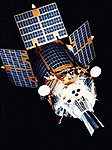
As Israeli officials pointed out to us, when reentering Scuds were intercepted or broke up on their own, they sometimes released a yellow-to-reddish-to-brownish cloud of the Scud's residual propellant oxidizer. People on the ground observing these clouds voiced concerns that the airborne releases involved chemical warfare agent. Incoming Al Hussein missiles contained about 300 pounds of residual oxidizer and 100 pounds of fuel. The oxidizer and accompanying oxides of nitrogen were dangerous in their own right and caused a range of symptoms in people exposed on the ground.[149]
Iraq's Scud oxidizer, inhibited red nitric acid (IRFNA), can cause deep and painful burns on the skin or in the lungs. When inhaled, the oxidizer and its nitrogen oxide decomposition products can produce immediate or delayed symptoms including throat dryness, cough, headache, dizziness, anxiety, extreme fatigue, nausea, vomiting, chest pain, labored breathing, inflammation of the lungs, choking, fluid build-up in the lungs, and suffocation, depending on the extent of exposure.[150] In interviews with our investigators, or during testimony before government panels, Gulf War veterans reported a variety of symptoms consistent with oxidizer exposure. Extracted from their accounts, these symptoms included tearing eyes, runny noses, nausea, vomiting, dizziness, sleeplessness, headaches, and blurred vision.[151] Kerosene, the fuel component of Scud propellants also escaped during breakups. Kerosene is not particularly toxic, even after acute exposure, and is used, for example, as barbecue lighter fluid and in jet fuels.[152]
Readers wanting additional information on Scud oxidizer should consult our information paper on IRFNA.[153]
VIII. COALITION RESPONSE TO SCUD THREAT
The Coalition took strong actions to protect forces and civilians and diminish the impact of Scud attacks. The Coalition considered Scuds a military and psychological threat to their forces, populations, and interests. Scud threat reduction efforts went forward on several fronts and included expanded surveillance and warning, deploying Patriot surface-to-air missiles with some ballistic missile intercept capability, air strikes against production and storage facilities, and attempts to destroy Scud units in the field before or after they launched missiles.[154]
The key component of the Scud alert process was the Defense Support Program surveillance satellites (see Figure 9)[155] that identified launches by detecting the infrared energy from a rocket in powered flight.[156] During Operation Desert Storm, United States Space Command quickly assessed the downlinked infrared detections and rapidly passed alert data to United States Central Command and other allies.[157] According to one source, military radars in the region could track missiles and aid in the extrapolation process to identify potential target areas.[158]
Figure 9. DSP surveillance satellite[159]
In another response to the Scud threat, the United States deployed Patriot surface-to-air missile units to Israel, Saudi Arabia, and Bahrain. Tab A includes a Patriot system description. Figure 10 summarizes the targets at which post-war analysis determined the Patriots fired.[160]
Figure 10. Patriots expended by target area
Part of the Coalition strategy for dealing with Scuds involved pre-planned air strikes against associated production and storage facilities.[161] These strikes were concentrated during the early part of the air campaign.[162]
Another component of United States reaction to protect Coalition forces was Scud hunting. Beginning with the initial Scud attacks against Israel on January 18, 1991, and Saudi Arabia on January 20, 1991, United States forces came under enormous pressure to do something about the immediate Scud threat. Reportedly, the United States leadership in Washington, DC, focused on the potential diplomatic and political fallout from Scuds, while most senior air commanders believed that Scuds "did not represent a particularly credible military threat" (emphasis original). As Air Force Lieutenant General Charles A. Horner, commander of the United States Air Force Component United States Central Command observed, the Scud was "a lousy weapon."[163]
Nevertheless, the Coalition diverted considerable resources to attempt to neutralize Iraq’s Scuds. Figure 11 displays in parallel graphs the number of total sorties dedicated to counter-Scud operations of all kinds (right) and the number of Iraq’s Scuds attacking the KTO and Israel (left). Day 1 was January 17, 1991, and Day 43 was February 28, 1991.
Figure 11. Scuds fired and anti-Scud sorties flown by day[164]
Scud units in the field proved difficult to locate and hit. What became known as "the Great Scud Hunt" had questionable operational effectiveness. As the United States Gulf War Air Power Survey noted, most, and possibly all of the 100 mobile launchers reported struck by Coalition aircraft appeared later to have involved decoys, other vehicles, or other objects that presented Scud-like signatures.[165]
| First Page | Prev Page | Next Page |